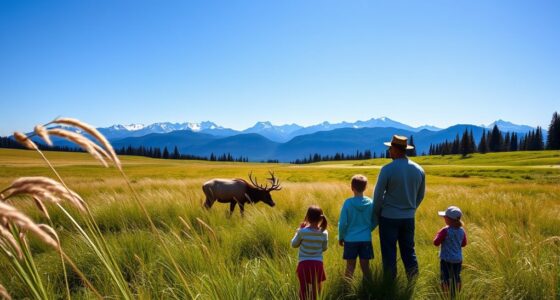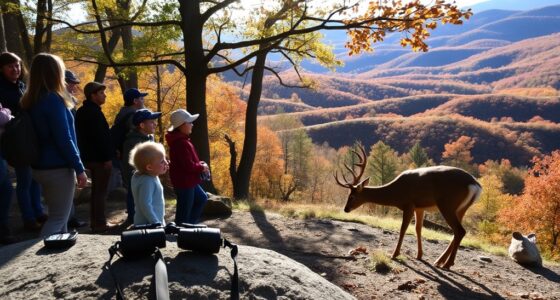To enjoy low-impact hiking in Big Bend National Park, stick to marked trails to protect delicate ecosystems and native plants. Carry out all trash, including food wrappers, to maintain the park’s pristine beauty. Wear appropriate footwear and stay aware of the rugged terrain and local wildlife. Embrace mindful observation, taking in the intricate details of your surroundings. By practicing these respectful habits, you’ll enhance your outdoor experience, and there’s more to discover about responsible hiking practices.
Key Takeaways
- Stay on marked trails to protect delicate ecosystems and prevent damage to native plants and wildlife.
- Carry out all trash, including food wrappers, to keep the park clean and pristine.
- Use biodegradable products and minimize waste to reduce your environmental footprint while hiking.
- Be mindful of noise levels, allowing others to enjoy the sounds of nature and wildlife.
- Educate yourself about local flora and fauna to foster appreciation and respect for the environment.

Have you ever wandered through a landscape that feels like a world of its own? Big Bend National Park offers you just that experience, with its stunning vistas and diverse ecosystems. As you hike through its vast terrains, you’ll encounter an incredible range of flora diversity that showcases nature’s artistry. From the towering cacti to the delicate wildflowers, each step reveals something new and beautiful, inviting you to immerse yourself in this unique environment.
Experience the enchanting landscapes of Big Bend National Park, where every hike reveals nature’s breathtaking artistry.
When you’re exploring these trails, it’s crucial to prioritize trail safety. Even in such a breathtaking setting, you can find potential hazards that require your attention. The rugged terrain, varying weather conditions, and the presence of wildlife mean you should always be prepared. Before you hit the trails, make sure you have a good map, adequate water supply, and wear appropriate footwear. You wouldn’t want to miss out on the park’s wonders because of an avoidable mishap.
While you take in the stunning flora diversity, be mindful of your surroundings. Stay on marked trails to avoid damaging the delicate ecosystems that thrive in Big Bend. By sticking to established paths, you help preserve the native plants and animals, allowing future visitors to enjoy the same beauty you’re experiencing. Small actions like this make a significant difference in maintaining the park’s integrity.
As you hike, don’t rush. Take the time to appreciate the intricate details around you. Observe the way the sunlight filters through the branches, creating a dance of shadows on the ground. Listen for the calls of birds and enjoy the rustle of leaves stirred by a gentle breeze. These moments not only enhance your hiking experience but also deepen your connection to nature. Incorporating natural materials in your gear can also enhance your experience and connection to the environment.
Remember, low-impact hiking means minimizing your footprint. Carry out what you bring in, including any food wrappers or trash. This practice ensures that the park remains pristine for all who visit. Your respect for the environment reflects your love for the great outdoors, and it encourages others to do the same.
In Big Bend National Park, every hike is an opportunity to learn and explore. By embracing trail safety and appreciating the flora diversity, you contribute to the preservation of this remarkable landscape. So next time you lace up your boots, keep these principles in mind, and enjoy the adventure that awaits you.
Frequently Asked Questions
What Is the Best Time of Year for Low-Impact Hiking?
The best time of year for low-impact hiking is typically in the spring and fall. During these seasons, temperatures are milder, making your hike more enjoyable. You’ll also find better trail accessibility, as snow and mud are less likely to be an issue. Keep in mind seasonal considerations like weather patterns and potential rainfall. Plan your hikes accordingly, and you’ll have a fantastic experience exploring the great outdoors.
Are There Guided Low-Impact Hikes Available in the Park?
Yes, you’ll find plenty of guided hike options that let you explore the beauty of nature while minimizing your impact. Think of these eco-friendly trail programs as a bridge connecting you to the park’s wonders, ensuring you tread lightly. Experienced guides lead you through stunning landscapes, sharing insights about the local flora and fauna. So lace up your boots and embrace the adventure, knowing you’re making a positive choice for the environment!
How Do I Prepare for Extreme Weather Conditions While Hiking?
To prepare for extreme weather conditions while hiking, you need to focus on hydration strategies and gear essentials. Always carry enough water and consider electrolyte packs for hot climates. Dress in layers to adapt to temperature changes and invest in waterproof gear if rain’s expected. A sturdy hat and sunglasses can shield you from the sun, while a first aid kit is crucial for emergencies. Stay informed about the weather forecast before you head out!
Are There Designated Low-Impact Hiking Trails in Big Bend?
Yes, Big Bend offers designated low-impact hiking trails. When you hike these trails, remember to follow trail etiquette and practice Leave No Trace principles. Stick to marked paths to minimize your impact on the environment, and always pack out what you bring in. Respect wildlife and avoid picking plants. By being mindful of your actions, you’ll help preserve the beauty of the park for future visitors while enjoying your adventure.
What Wildlife Should I Be Aware of While Hiking?
While hiking, you should be aware of various wildlife encounters, including snakes, mountain lions, and bears. It’s essential to take safety precautions, like making noise to avoid surprising animals and keeping food stored properly. Always stay on marked trails, as this reduces the chance of an unexpected encounter. If you see wildlife, observe from a distance and never approach or feed them. Being informed helps guarantee a safe and enjoyable hiking experience.
Conclusion
So, lace up your boots and step into the enchanting embrace of Big Bend National Park. Each trail whispers tales of ancient landscapes and vibrant wildlife, inviting you to dance with nature at a gentle pace. As you wander through this vast canvas of rugged beauty, let the soft rustle of leaves and the warm sun guide your spirit. You’ll find that low-impact hiking here isn’t just a journey; it’s a soul-stirring adventure, painting memories that last a lifetime.










